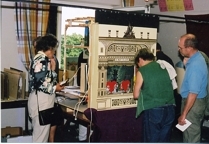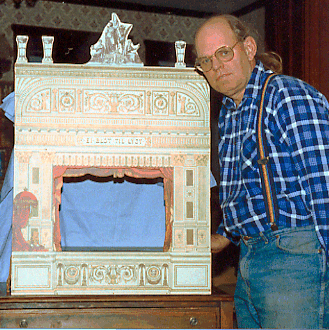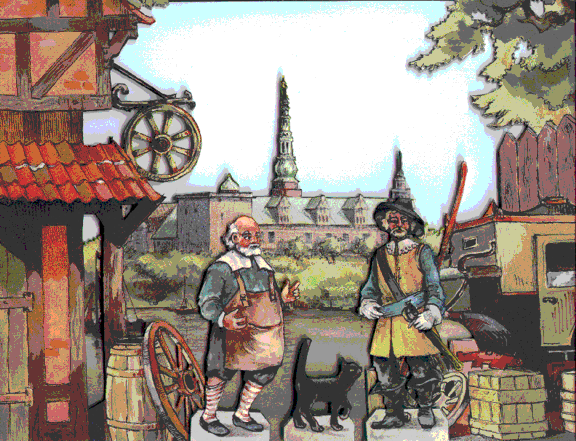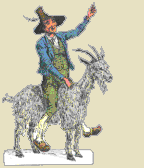|
All artwork and content of this site are ©
Copyright 2003-2010 Kannik's Korner and its licensors.
All rights reserved.
|
| |
|
About Model Theater,
a Glimpse of History
Model theater is called "Dukketeater",
or doll theater, in Denmark, and "Kindertheater", or children's
theater, in Germany. Other countries produced model theaters, but the prints from Denmark and Germany were some of the most
outstanding. It is still commonly known as Toy Theater, despite the fact
that it is mostly adults involved in creating and performing, rather
than children.
Right: Visitors at the Preetz, Germany
toy theater festival examine the workings of a Large, C size,
Alfred Jacobsen style Royal Theater (click
for larger view)
|
|
 |
|

Above: Fritz with a Royal Theater,
shown without curtain. (Poor color, sorry!)
(click
for larger view)
|
Victorian era paper theaters, or model theaters, published by Alfred Jacobsen (from Denmark),
were one of my hobbies as a child. Most of these had been collected by my family. I still maintain an interest in this fascinating
and creative hobby. There are beautifully printed figures, like paper dolls,
and scenes with many different
plays from the real stage. Many of the original plates are being re-printed, and are
available today. Lighting and special effects are the added attractions, making the plays
truly exciting, even in today's world of computers and animation!
|
This is a wonderful family hobby, involving pasting and
cutting figures and scenery, building the stage, developing lighting, creating sound
effects, inventing special effects and moving figures (even trap doors), and then actually
performing the play!* People who enjoy model building, paper cut-outs, stage
building, set design, puppets, acting and performing, story telling, doll
houses, paper dolls, theater and theater history, are among those who
love model theater.
|

Above: Figures, including the black
cat, and scenery from
"The Spy from Elsinore."
(click
for larger view) |
Model or Paper Theater, is usually sold as printed paper sheets, either in black & white to be
colored as desired,
or as full colored images of the figures, props and scenery. The sheets are then pasted to
thin cardboard, backed with another piece of paper to keep the cardboard from curling, and
then left to dry well. After it is dried, it can be cut out with scissors or
craft knives,
and some people use special chisel-like tools.* The more precise and finer detailed
the cutting, the
better the sets will look. It is more time consuming, but the result is much more
effective than when cut too coarsely.
|
|
The detail gives the realistic look. Sometimes things are cut so fine that
they must be supported with wire or fine sticks; or strung with strings to replace ropes
and other such fine details. Other special effects are created with moving parts of
figures and props. Some figures are designed so that they can be rotated to show two
"sides" of a character, or to move the character in opposite directions across
the stage, which prevents the character having to back out of the scene.
|
|
 The figures are controlled and moved by the use of sticks with small bases to
which the figure either attaches, or, into which the base of the figure slips. The figures
are then slid onto the stage, and the smoother the motion, and the more appropriate the
motion to the words and action of the plays, the more effective the figure. The figures are controlled and moved by the use of sticks with small bases to
which the figure either attaches, or, into which the base of the figure slips. The figures
are then slid onto the stage, and the smoother the motion, and the more appropriate the
motion to the words and action of the plays, the more effective the figure.
Some professional performers use pre-recorded soundtracks so that they can
incorporate more sound effects, music, variety of voices, and are free to move the
figures, props, operate the lighting and perform special effects. Of course, this is a
modern addition, and it is perfectly wonderful to perform with just the family or friends
participating and incorporating contrived sound effects!
Some of the Alfred Jacobsen toy theater plays, originally written in
Danish, are available today with an English text.
Go to the
Toy Theater Plays
page to learn more about them! |
Wave machines are one example of moving
props, and are used in
producing plays with ocean scenes.
The original waves for this machine were printed by Alfred Jacobsen.
The printed sheet is available, P-407. |
 |
* Due to the nature of the sharp craft knives and other tools frequently
employed by model theater enthusiasts, the cutting out of figures and
scenery is NOT for young children!!! Parents, guardians, and teachers,
please use common sense in judging the skill levels of your children, and
keep knives, sharp tools, model theater accessories and small parts away
from small children, or those who do not have the skill level to use them.
Please also keep tools, pastes and other craft items away from your pets.
Be sure to visit my bibliography of Books related
to Toy Theater. For more information on other toy theaters, see my Toy Theater Links page. |
|